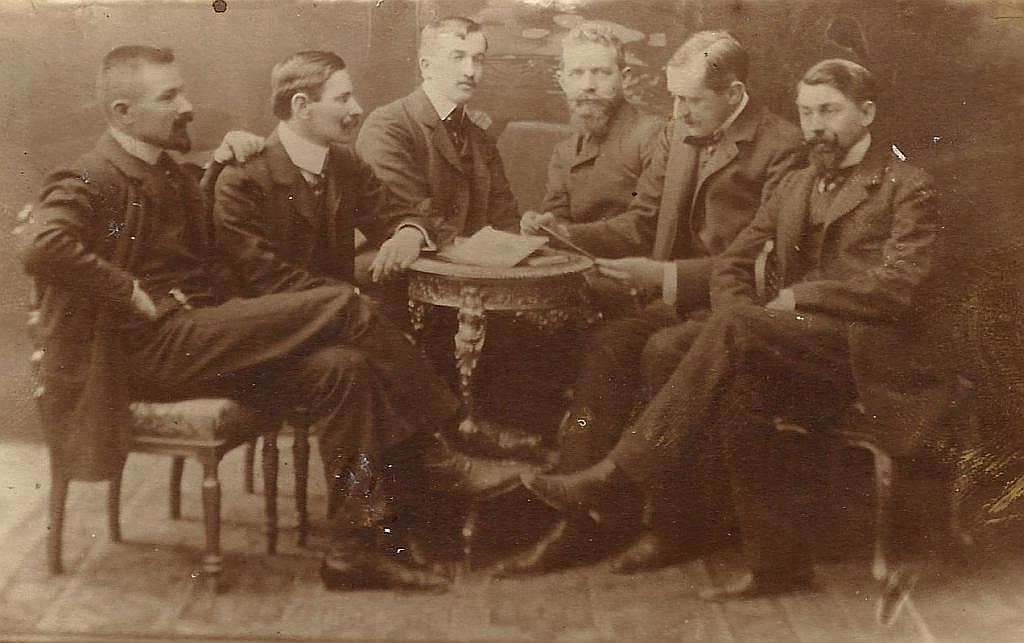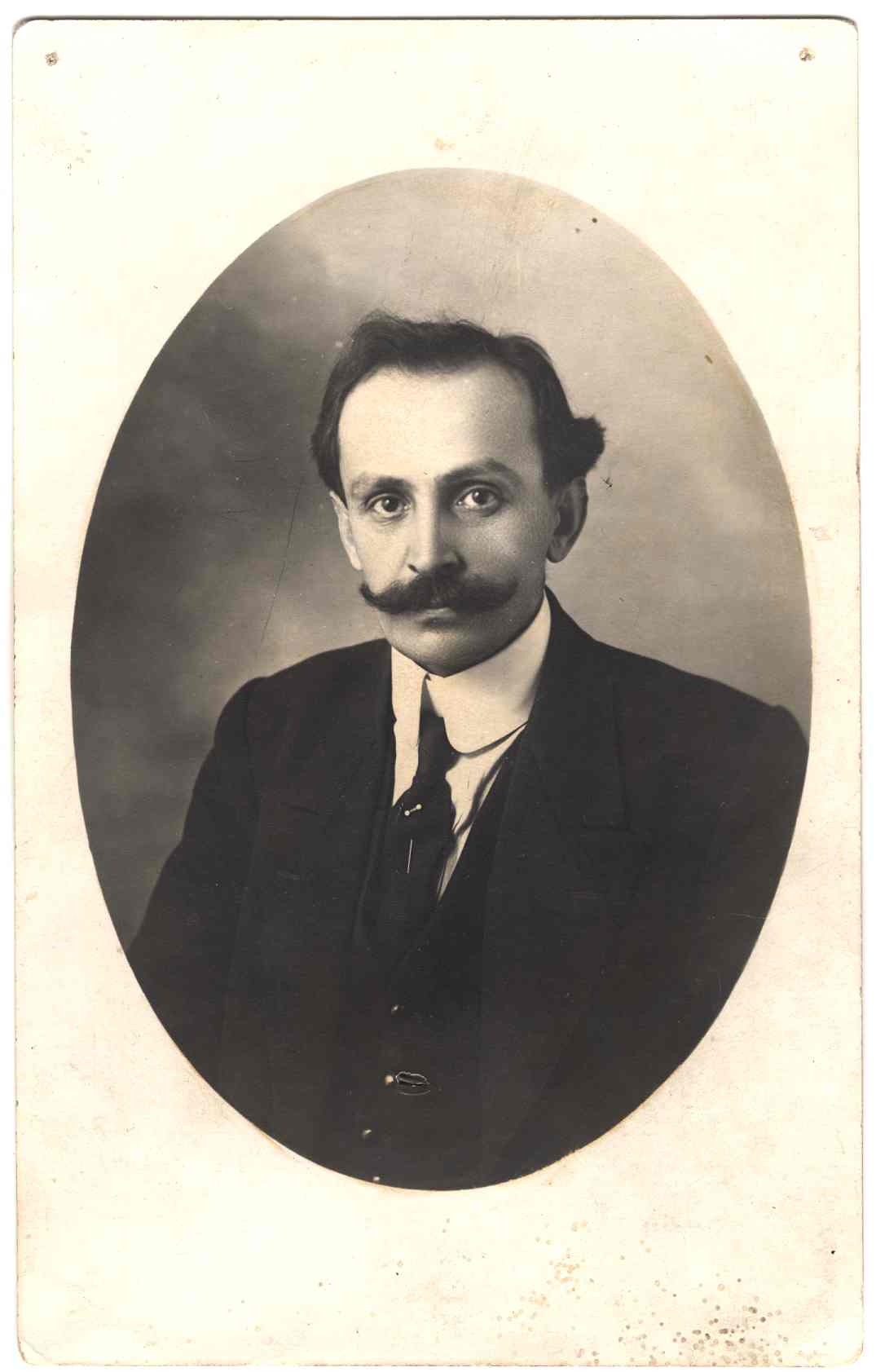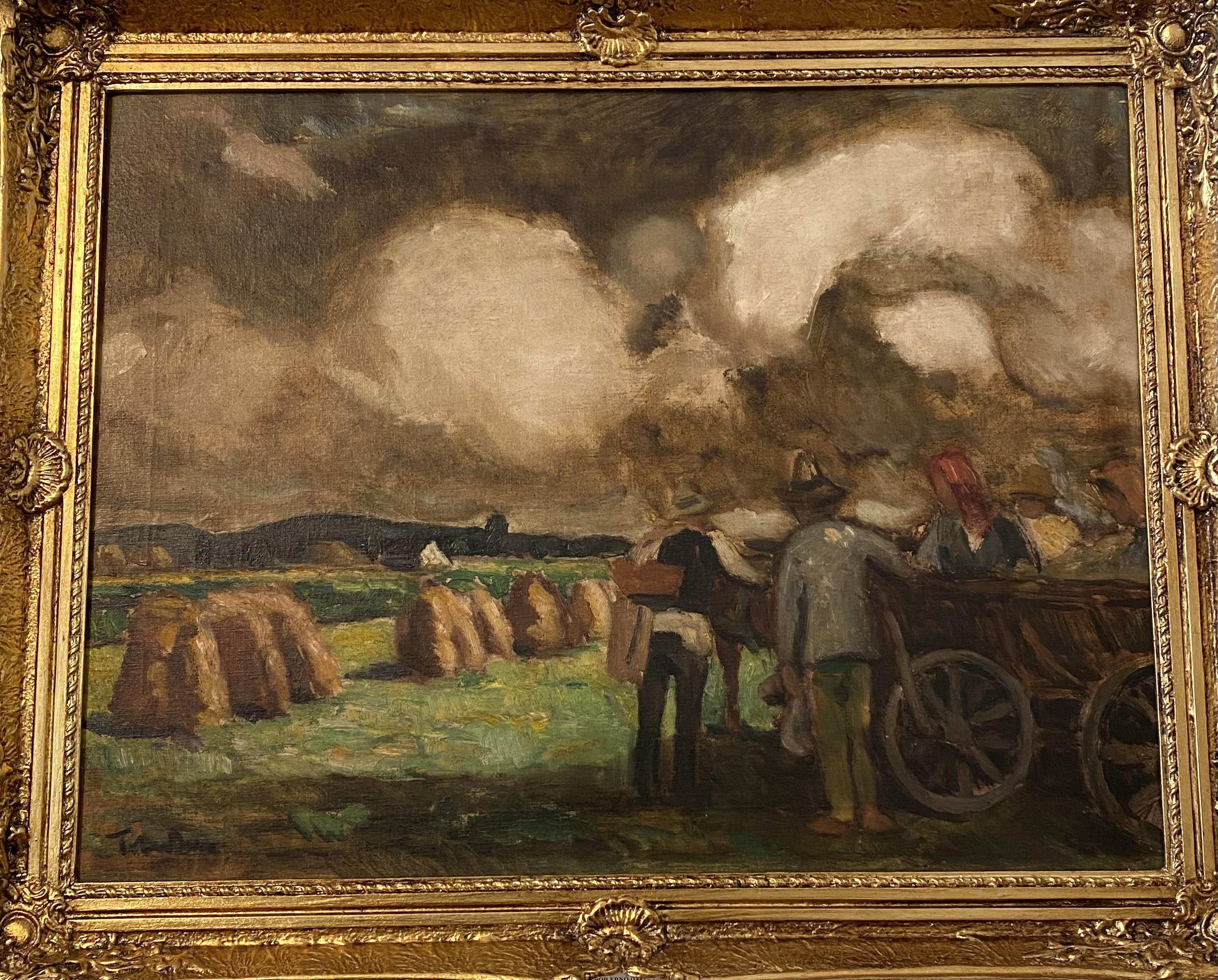ARTNOUVEAU2 - Enriching knowledge about Art Nouveau online
26-04-2022
Within the ArtNouveau2 project, we place emphasis on the promotion of cultural heritage through the joint action of all partners making posts on social media with the activity Enriching knowledge about Art Nouveau online.
Read what we have prepared in April on the common topic of Art Nouveau artist:
GROUP OF ARTISTS WHO WORKED AT THE ZSOLNAY-FACTORY, PÉCS (1901)
The factory employed several sculptors, painters and craftsmen for its designs at the turn of the 19th and 20th centuries. The group photo taken in Pécs includes Henrik Darilek, Géza Nikelszky, Sándor Apáti Abbot and Lajos Mack, who enriched the company's product range with unique designs and creations. You can discover their works in the exhibition entitled Our Art Nouveau if you visit the Ráth György Villa.
The products of the Zsolnay factory, alongside the majestic building ceramics that adorn the Museum of Applied Arts and many turn-of-the-century institutions, Zsolnay bowls, vases and porcelain ornaments used as decorative objects are also outstanding works of the Art Nouveau period.

Group of Art Nouveau artists, photography @IMM
OSVALD POLÍVKA (1859–1931)
This leading architect active at the turn of the 19th and 20th centuries was a pioneer of Art Nouveau architecture and became famous for the designs of several Czech banking houses and insurance companies. In Bratislava, in 1924 he built a residential house in Art Nouveau style on Sienkiewiczova Street no. 4., near the Blue Church (by Ödön Lechner ).

Portrait of the Czech architect Osvald Polívka (1859 - 1931) published in Světozor (1895-6), issue 52, digitized by Czech Academy of Sciences. Public domain.
CECILIA CUȚESCU-STORK (14 March 1879 – 29 October 1969)
Our series dedicated to the #ArtNouveau heritage of our country continues, this time focusing on an artist representative of this movement. We invite you to (re)discover a personality of Romanian plastic art - her remarkable bibliography and a matching cultural heritage: Cecilia Cuțescu-Stork (see hereby self-portrait).

Woman in Landscape Self-portrait by Cecilia Cuțescu Stork, 1910. Part of Romania’s National Art Museum’s collection. © NIH / INP - Digital Heritage Department
Born on March 14, 1879, in rural Vâlcea, Southern Romania, Cecilia Cuțescu-Storck has gone down in history as one of the most representative female figures on the Romanian fine arts scene. She attended high school in Bucharest - with the support of her grandparents on her mother's side, whose name - Cuțescu - she kept until the end of her life. At a very young age she went abroad to study drawing and painting at the Damenakademie in Munich and then to Paris (at the Académie Julien and the École des Beaux-Arts). She returned to Romania in 1906 and became a member of the Tinerimea Artistica Society (Artistic Youth Society), an association that aimed to introduce a modern, western spirit, independent of the official movement in Romanian art. It was the beginning of an artistic career of more than 50 years, which was to consecrate her alongside other more prominent names of her time such as Camil Ressu, Gheorghe Petrașcu or Jean Alexandru Steriadi. It was also the beginning of a fight for women's rights, with Cecilia Cuțescu-Stork founding, together with Olga Greceanu and Nina Arbore, the "Association of Women Painters and Sculptors".
In 1916, Cecilia became the first woman professor in a state art academy in Europe (Academy of Fine Arts in Bucharest - Department of Decorative Art and Painting, which she coordinated until 1941).
Leafing through a copy of the 1943 edition of her memoirs "A life’s frescoe", we came across a dedication written by the painter, most likely to one of her students: "When will it be understood how much the wasted work of women can serve this nation? Thinking of the devotion of your nature, it is with great pleasure that I offer you this volume of confessions" Cecilia Cuțescu-Stork, artist-painter.
The attached portrait was chosen to sync with the artist’s feminist endeavours - a self-portrait from the height of the era of female emancipation, entitled Woman in Landscape (photo) - in which Cecilia Cuțescu-Storck represents herself in nature, in a courageous pose that seems to defy the viewer.
Cecilia Cuțescu-Storck's work in the field of fine arts has many levels and achievements. In order to understand the influence that Munich and Paris had on the artist during the booming years of the Jugendstil / Art Nouveau movement in Europe, we invite you to explore the Storck couple's home in Bucharest. At once a place of work, socialization, exhibition and teaching, the home of Cecilia Cuțescu Stork and her husband, the sculptor Frederic Stork, was the ideal space in which the artist made her debut with the series of monumental murals for which she became known. Drawing inspiration from a wide range of sources - from symbols of Romanian culture and society to the organic natural elements so common in Art-Nouveau - but faithful to her personal and modern visions, Cecilia creates here a space synonymous with freedom of taste, evoking harmony and transforming, as the artist herself declared, the aspiration of mural painting into an ideal. After the murals in her own home proved Cecilia Cuțescu-Storck's talent, several important commissions followed. Worthwhile mentioning is the mural painting titled"Agriculture, Industry and Trade", which can still be admired today in the hall of honour of the headquarters of the former Marmorosch-Blank Bank in Bucharest, (the most important banking institution at the time), - a building designed by architect Petre Antonescu that has recently been restored.
JOSEF HOFFMANN (1870-1956)
Born in Brtnice, Czech Republic, in 1870, the architect, designer, teacher and exhibition organizer Josef Hoffmann is one of the central figures of Viennese Modernism and the international Lebensreform (life reform) movement around 1900.
As co-founder of the “Vereinigung bildender Künstler Österreichs – Secession”, the Wiener Werkstätte, and the “Österreichischer Werkbund”, Hoffmann had a decisive influence on modern Viennese design.

Josef Hoffmann (1870-1956), Photography, © MAK
BRANKO TANAZEVIĆ (1876-1945)
He was the most prominent architect of the national style in Serbian architecture until 1914, affirming the symbiosis of elements of secession and Serbian motives creating a version of so-called Moravian secession. National style architects do not rely only on secession in theory, but also in composing and decorating buildings in Art Nouveau manner, and their buildings really seem as secession works (something similarly happened in the national architecture of the Danube countries, for example in Hungary, folklore motives are used on secession composed structures).
Branko Tanazević was born in 1876 in Čakovo, Banat, Austro-Hungarian Empire. He graduated Mechanical Engineering in Belgrade, Faculty of Technical Sciences, as well as architecture in Munich. Tanazević is significant because of the fact that he published his perceptions of the profane architecture of national direction in the professional periodicity and thus became the kind of ideologist of this type of Serbian architecture. He was also a critic of the mimetic and arbitrary creations in that style. He researched old monuments and passed that knowledge as a teacher of the Faculty of Architecture on Ornaments and Town Planning subjects. Buildings of Branko Tanazević have a specifically modernized national character since their builder advocates modern transposition of old heritage. Academism was embedded in the disposition of the foundations of its buildings, but the general secessionist spirit distanced those parts from the orthodoxly understood Serbian style. As a real creator he affirmed the view that the traditional architectural masterpiece was upgraded with modern fine arts and adapted to the needs of the 20th century by rejecting the possibility of a direct continuation of the medieval tradition. The concept is to present three cultural monuments made for different purposes by one architect in this unique Moravian secession manner.

Branko Tanazević (1876-1945), Photography, © Belgrade City Museum
ANTONIJA KRASNIK (Lovinac, 1874 - Zagreb, 1956)
Antonija Krasnik is a versatile Croatian designer, painter and sculptor. She was educated in Zagreb, Vienna and Paris. She studied in Vienna in the class of prof. Koloman Moser, who sought to permeate the artistic craft and art, which certainly influenced Krasnik. In addition to painting and sculpture, she also worked on designs for glass and ceramic objects and less useful objects made of precious metals and silver.
She was known to European connoisseurs of applied art, glass dealers used her designs, and her works have been published in many important journals. By participating in an exhibition in Paris in 1900, Antonija Krasnik was the first in the world to promote Croatian design of Art Nouveau features.
When working in glass, form balances between organic figurality and abstraction. Her works in metal, on the other hand, are characterized by pure geometric shapes as the basic form, most often decorated with abstract, geometric patterns, with the presence of accentuated figurative detail.

Antonija Krasnik (around 1907), unknown artist, oil on canvas, © MUO Painting Collection
RIMANÓCZY KÁLMÁN JUNIOR (April 30, 1870 - July 12, 1912)
He was the most important architect from Oradea in the period 1900-1912. Born in 1870 in Oradea, with his studies in Berlin (Technische Hochschule in Charlottenburg, 1892) and Budapest (at the workshop of the famous professor Czigler Győző) returning to Oradea in 1891, Rimanóczy jr. made a name for itself in the city's architecture during the most flourishing days of Art Nouveau.
For a decade, the famous architect implemented his best ideas, modeling the urban map of the city on Crisul Repede, thus enriching the architectural heritage. The imposing buildings designed by him still stand today, the palaces and public institutions designed or built by him in the eclectic style characteristic of the Art Nouveau period are the most important buildings around the central squares. The industrial objectives designed by him were designed based on their functionality, but with a spectacular architectural aspect. His architectural office was located on the current King Ferdinand I Street. He was a successful architect and entrepreneur, and in this last capacity he collaborated in the construction of the building of the Oradea Theater and the Lutheran Church in Tudor Vladimirescu Street, named after him. Rimanóczy Kálmán Junior had numerous orders for public buildings in Oradea, mansions and castles and churches in Bihor County, constructions made in various stylistic ways: neo-renaissance, with neo-gothic elements, Lilienstil, neo-classicist or art nouveau.


Two photos of Deutsch K. Ignác glass shop, Vasile Alecsandri street no. 4, Oradea, Romania, Viennese secession style, the buiding and one with the detailed painting,1888., @OradeaHeritage
TIBOR ERNŐ (1884-1945)
Also called the painter of Oradea, he was a lover of the streets of Oradea, and this connection between the artist and the city can be deciphered in his paintings, some themes being re-imagined and reinterpreted by him.
The painter Tibor Ernő (Fischer Tibor) was born in Oradea on February 28, 1885, he attended high school at the Royal High School, with well-trained teachers, here he begins to draw, in front of the board showing a coloristic force. At the end of high school he will join the avant-garde literary-artistic movement in Oradea, being supported by the members of the circle, including the poet Ady Endre. In 1904, he received a scholarship from the city council and went to the Academy of Arts in Budapest, where he taught Zemplény Tivadar and Ferenczy Károly.
In August-September 1907 he will open a personal exhibition at the Great Hall of the Citadel of Oradea, presenting 125 works, oil and watercolor (Self-portrait, Portrait of the poet Ady Endre, landscapes: Sunset at Pont-Aven, Luxembourg Park, Parisian Roofs, Before the storm, etc.).
In 1908 he opened a painting school in Oradea and in the autumn of the same year he participated with four paintings in the exhibition in Budapest: Fish Fair in Concarneau, Sunny Sea, Agitated Waves and Composition, received good reviews.
On Feb. 14. In 1909, an exhibition of Impressionist and naturalist painters opens at the Budapest National Salon, in which Tibor Ernő participated with a large painting, Oradea Market(a theme with several variations). It was a year full of exhibition activities: in the exhibition hall in the Black Eagle Passage he exhibits with the painter Mikes Ödön, this being followed by an exhibition in Timișoara. In November he goes on a four-month trip to Italy and will return with 60 Italian paintings: Venice, Burano, Murano, Chioggia. This last painting attracted the appreciation of specialists from Budapest.
In January 1911 he reopened the art school under the Black Eagle Passage in Oradea, in June he went on a study trip to Munich, visiting the artists' colony of Dachau (August 13, 1911), a town on the Amper River, he returned to Oradea with paintings as the Amper River and the Dachau Peasants return home to attend an exhibition in Vienna.
His exhibition activity has been particularly intense, his works have been present at various cultural events and exhibitions. His almost annual trips to France and Italy posed new artistic challenges. His creations dedicated to people in full activity, related to the spirit of nature are full of dynamism. The urban landscapes painted in Oradea prefer the evocative browns leaning towards red, reddish brown buildings and reddish roofs. Brown is ubiquitous on the walls, on the crown of trees in the autumn light.On May 3, 1944, he was deported to the extermination camps, reaching the Dachau camp, Kaufering. The irony was that in 1911 he painted in the Dachau artists' colony, returning as a prisoner. He died in the camp on April 20, 1945, 12 days before the camp was liberated.

Photo credit: Rural landscape - Oil painting, around 1915, @OradeaHeritage
Lead partner: City of Oradea (Oradea Municipality)
Other partners: Oradea Heritage and Foundation for Protection of Historical Monuments from Bihor County; National Institute of Heritage, Bucharest; Iparművészeti Múzeum, Budapest; Museum of Arts and Crafts, Zagreb; Museum of Applied Arts, Vienna; Slovak University of Technology, Bratislava; Republic Institute for Protection of Cultural Monuments, Belgrade; Kodolányi János University, Budapest.
Project co-funded by European Union funds (ERDF, IPA II).
